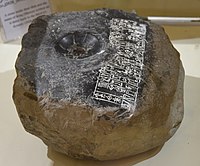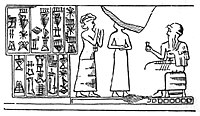Shu-Sin
| Shu-Sin 𒀭𒋗𒀭𒂗𒍪 | |
|---|---|
| |
| Reign | c. 2037 BC – 2028 BC
(Middle Chronology) c. 1973 BC – 1964 BC (Short Chronology) |
| Predecessor | Amar-Sin |
| Successor | Ibbi-Sin |
| Issue | Ibbi-Sin |
| Dynasty | 3rd Dynasty of Ur |
| Father | Shulgi |
Shu-Sin, also Šu-Suen (
Reign
Following an open revolt of his
An erotic poem addressed to Shu-Sin by a female speaker is preserved in a cuneiform tablet.[2] The poem's speaker expresses her strong desires and longings for the king.[3][4][5]
An inscription states that he gave his daughter in marriage to the ruler of Šimānum "His daughter was given as a bride to Simanum. Simanum, Habura, and the surrounding districts rebelled against the king, they chased his daughter away from her residence." Shu-Sin subsequently conquered Šimānum and restored his daughter there.[6]
Year names of Shu-sin
The year names for the reign of Shu-sin are all known and give an information about the events of his reign. The most important ones are:[7]
1 Year Szu-Sin became king
2 Year Szu-Sin the king of Ur made / caulked the boat of Enki (called the) 'ibex of the abzu'
3 Year Szu-Sin the king of Ur destroyed Simanum
4 Year Szu-Sin the king of Ur built the amurru wall (called) 'muriq-tidnim / holding back the Tidanum'
6 Year Szu-Sin the king of Ur erected a magnificent stele for Enlil and Ninlil
7 Year Szu-Sin, the king of Ur, king of the four quarters, destroyed the land of Zabszali
9 Year Szu-Sin the king of Ur built the temple of Szara in Umma
Artifacts
There is vast number of artifacts with inscriptions in the name of Shu-sin.[8]
-
Door socket inscribed with the name of Shu-Sin, king of Ur, Ur III. From Mesopotamia, Erbil Civilization Museum.
-
Inscription with the name of Shu-Sin
-
Seal of Shu-Sin: "Shu-sin, the Great King, King of Ur, King of the four world quarters..."
-
Inscribed stone ring of a fountain, in the name of king Shu-Sin. Pergamon Museum.
-
Inscription of King Shu-Sîn, commemorating the construction of the temple of the god Shara at Umma. Musée national d'histoire et d'art, Luxembourg, Cabinet des Médailles.
See also
- A Love Song of Shu-Sin (B)
- History of Sumer
- Sumerian king list
References
- ^ "Sumerian King List", Wikipedia, 2022-11-29, retrieved 2022-12-05
- ^ "Oldest love poem". Guinness World Records. Retrieved 2019-07-18.
- ISBN 9780802828811.
- ^ Longman, Tremper III; Enns, Peter (2008-06-06). Dictionary of the Old Testament: Wisdom, Poetry & Writings: A Compendium of Contemporary Biblical Scholarship. InterVarsity Press.
- ^ "The World's Oldest Love Poem". World History Encyclopedia. Retrieved 2019-07-18.
- ^ Michalowski, Peter, "The Bride of Simanum", Journal of the American Oriental Society, vol. 95, no. 4, pp. 716–19, 1975
- ^ "T6K4.htm". cdli.ucla.edu.
- ^ "CDLI-Found Texts". cdli.ucla.edu.
- PMID 34206575.
- ISBN 978-1-58839-205-3.
- Nicole Brisch, The Priestess and the King: The Divine Kingship of Šū-Sîn of Ur, Journal of the American Oriental Society, vol. 126, no. 2, pp. 161–176, (Apr. - Jun., 2006)
- Stiebing Jr., William H. (2003). Ancient Near Eastern History and Culture. New York: ISBN 0-321-06674-X.






![Seal of Abbakalla of Ur, riding a horse (reign of Shu-Sin, UR III, 2037–2028 BCE), one of the first known such depiction.[9][10]](http://upload.wikimedia.org/wikipedia/commons/thumb/2/23/Seal_of_Abbakalla_of_Ur%2C_riding_a_horse_%28reign_of_Shu-Sin%2C_UR_III%2C_2037%E2%80%932028_BCE%29.jpg/200px-Seal_of_Abbakalla_of_Ur%2C_riding_a_horse_%28reign_of_Shu-Sin%2C_UR_III%2C_2037%E2%80%932028_BCE%29.jpg)